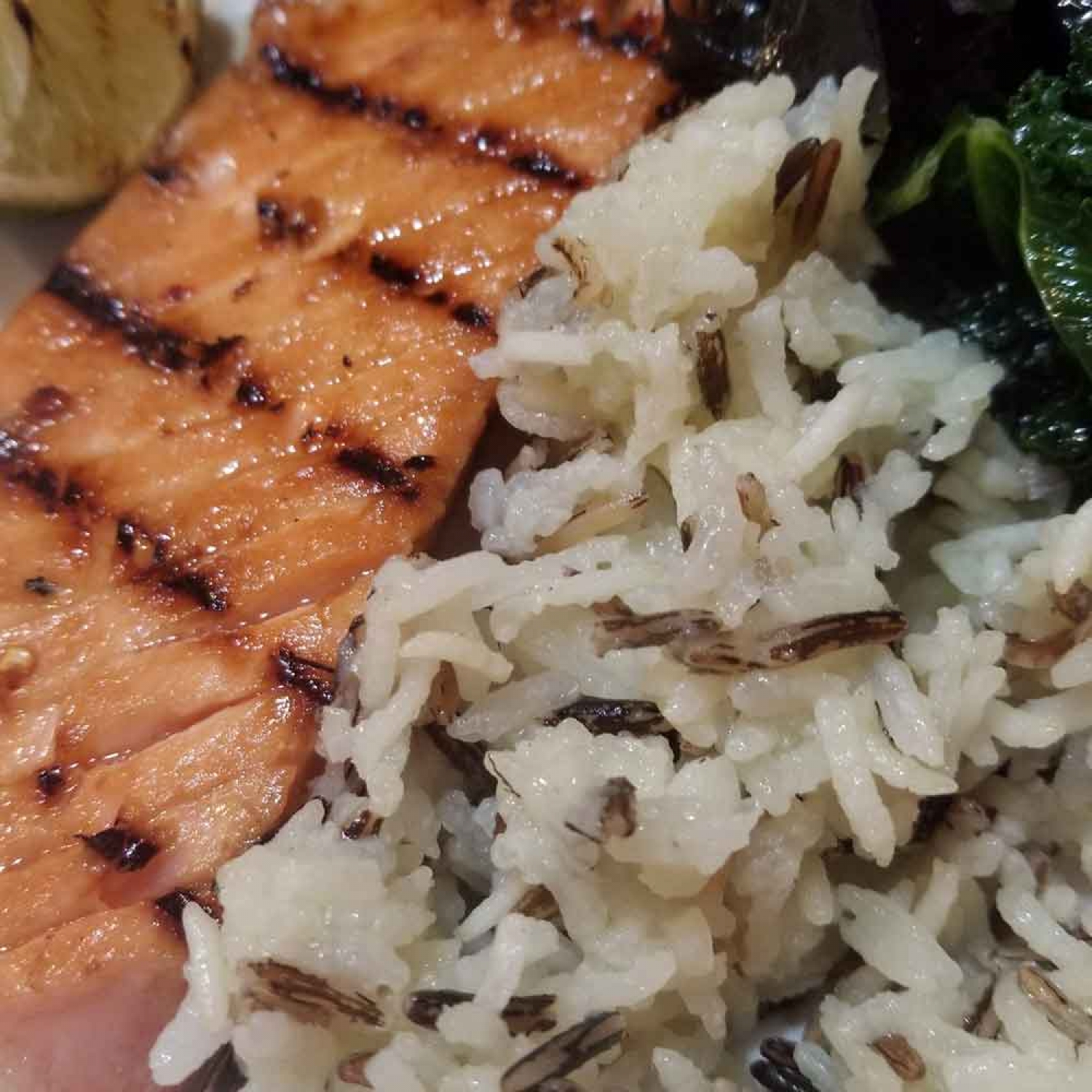The Paleo Diet for Diabetes
In This Section
- What is the Paleo Diet?
- Can a Paleo Diet Benefit People with Diabetes?
- Getting Started with a Paleo Diet
- References
What is the Paleo Diet?
Paleo stands for “Paleolithic,” a prehistoric era spanning over 2.5 million years. During these times, people were hunters and gatherers. This means that they ate meat, fish, and seasonal plants, such as foraged berries, vegetables, roots, and nuts. They did not eat processed foods, like refined sugars, any grains, or dairy.

From an evolutionary perspective, many people believe that this is the kind of diet that we are adapted to eat. The health benefits of eating nutrient-dense, less processed food are well- established. The current dietary guidelines emphasize the benefits of focusing on nutrient- dense vs. processed foods.
Can a Paleo Diet Benefit People with Diabetes?
Because it focuses on nutrient-dense foods, avoiding processed ingredients, sugar, and grains, a Paleo diet is likely to be lower in carbohydrate content than a more traditional western diet. Minimizing the number of carbohydrates, while consuming more foods that are lower on the glycemic index, such as non-starchy vegetables, may help more effectively manage blood glucose levels. In fact, some researchers suggest that limiting carbohydrate intake should be the main tool for managing type 2 diabetes and an important supportive treatment to insulin therapy for type 1 diabetes.
Several studies have been conducted to evaluate the effects of the Paleo diet on type 2 diabetes management, demonstrating the potential health benefits of the diet. Specifically, research studies indicate that adhering to a Paleo diet is effective in lowering BMI and A1C levels in patients with type 2 diabetes.
At least one study showed that a Paleo diet resulted in lower average triglycerides and blood pressure in type 2 diabetics in comparison to those following a more traditional diet. Research also suggests that eating Paleo, even for a short period, can result in improved insulin sensitivity and lipid profiles. Interestingly, when compared to a Mediterranean diet, following a Paleo diet resulted in significantly improved glucose tolerance in patients with type 2 diabetes.
Little research has been conducted to specifically evaluate the effects of the Paleo diet on type 1 diabetes management. However, it has been shown that reducing carbohydrate intake results in markedly fewer hypoglycemic episodes, and lower A1C and triglyceride levels in patients with type 1 diabetes. Furthermore, one study demonstrated the effectiveness of a Paleo-ketogenic diet in increasing insulin production in a newly-diagnosed type 1 diabetic, whereby adhering to the diet significantly delayed the need for insulin therapy.
In conclusion, although additional research will yield a more comprehensive understanding, it appears that a Paleo diet can be beneficial for those trying to optimize their blood glucose levels and other metabolic parameters.
Getting Started with a Paleo Diet
Whether you want to eat Paleo strictly or just incorporate more hunter/gatherer type meals, the first thing to do is to reduce the amount of processed food and items that contain added sugar. Items like soda, donuts, and chips do not have a place in the Paleo pantry.
Reducing or eliminating products with grains, like bread, tortillas, croissants, and muffins in the next logical step in adopting a more Paleo-type diet. Any grains, including rice and quinoa, are also not Paleo items. Shifting the focus from eating grains to vegetables, nuts, and fruit to obtain essential nutrients is key.
Finally, eliminating dairy items, like milk and cheese round out the list of items that are not Paleo-friendly.
Some examples of nutrient-dense Paleo foods include non-starchy vegetables like zucchini,
broccoli, asparagus, avocados, and bell peppers. Berries and nuts are also great choices, as they are high in nutrients and fiber, and low in carbohydrate and low-glycemic options. Meats, fish, and eggs are all great sources of protein, and coconut and olive oils are some Paleo- friendly choices for cooking.

Since following the Paleo diet involves cutting out grains and dairy, it is important to take care to consume enough fiber and calcium. Eating plenty of high-fiber veggies, nut, seeds, and berries should allow for sufficient fiber intake in the absence of grains. Eating enough vegetables that are rich in calcium, such as kale, spinach, and broccoli will help meet that nutritional need.
There are variations of the Paleo diet – some people choose to keep it very low-carb, or even ketogenic, and do not consume starchy vegetables or fruit at all. Others choose to include the starchy vegetables and fruit in their diet.
The apples and bananas of today are very different in composition than those of the Paleolithic period. In more recent history, fruit has been selectively bred and manipulated. As a result, today’s fruit are much larger and higher in sugar content than their predecessors.
Whether you are strictly following the diet, or just making an effort to incorporate more whole, unprocessed foods, it’s vital to keep an eye on the carbohydrate count. Paying close attention to blood glucose trends and making adjustments to your medications as necessary in response to changes in the diet is also very important.
References
Andrikopoulos S; “The Paleo diet and diabetes” (2016) The Medical Journal of Australia 205(4): 151-152. Accessed 3/15/2018 https://www.mja.com.au/journal/2016/205/4/Paleo-diet- and-diabetes
Feinman RD, Pogozelski WK, Astrup A, Bernstein RK, Fine EJ, Westman EC, Accurso A, Frassetto L, Gower, BA, McFarlane SI, Nielsen JV, Krarup T, Saslow L, Roth KS, Vernon MC, Volek JS, Wilshire GB, Dahlqvist A, Sundberg R, Childers A, Morrison K, Manninen AH, Dashti HM, Wood RJ, Wortman J, Worm N; “Dietary carbohydrate restriction as the first approach in diabetes management: Critical review and evidence base” (2015) Nutrition 31(1): 1-13. Accessed 3/19/2018 https://www.sciencedirect.com/science/article/pii/S0899900714003323
Klonoff DC; “The Beneficial Effects of a Paleolithic Diet on Type 2 Diabetes and Other Risk Factors for Cardiovascular Disease.” (2009) Journal of Diabetes and Science Technology 3(6): 1229-1232. Accessed 3/15/2018 https://www.ncbi.nlm.nih.gov/pmc/articles/PMC2787021/
Nielsen JV, Jonsson E, Ivarsson A; “A low carbohydrate diet in type 1 diabetes: clinical experience—a brief report” (2005) Upsala Journal of Medical Sciences110(3): 267-273. Accessed 3/15/2018 https://www.ncbi.nlm.nih.gov/pubmed/16454166
Toth C and Clemens Z; “Type 1 diabetes mellitus successfully managed with the Paleolithic ketogenic diet” (2014) International Journal of Case Reports and Images5(10): 699-703. Accessed 3/15/2018 https://www.researchgate.net/publication/267810000_Type_1_diabetes_mellitus_successfully_m anaged_with_the_Paleolithic_ketogenic_diet
United State Department of Agriculture; “Dietary Guidelines for Americans 2015-2020, Eighth Edition” (2015) Accessed 3/19/2018 https://health.gov/dietaryguidelines/2015/resources/2015- 2020_Dietary_Guidelines.pdf
Originally published by Diabetesdaily.com: diabetesdaily.com/learn-about-diabetes/diabetes-diet/the-paleo-diet-for-diabetes/

